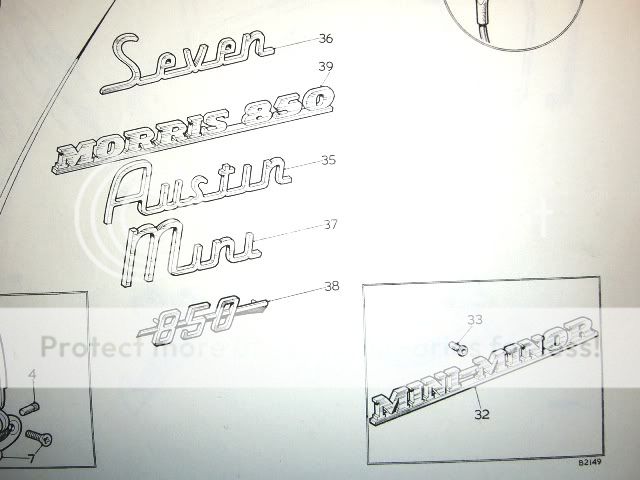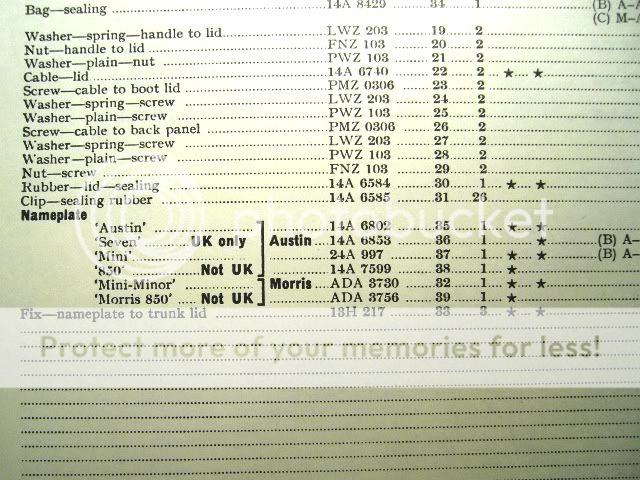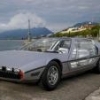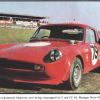Edited by Gary C, 14 January 2011 - 20:44.

Austin Mini A7 ?
#1

Posted 14 January 2011 - 20:40
Advertisement
#2

Posted 14 January 2011 - 20:55
edit: see the pics on this blog (in Thai!)
http://mrdiecastman....se7en-mini.html
Edited by Vitesse2, 14 January 2011 - 21:00.
#3

Posted 14 January 2011 - 22:47
#4

Posted 15 January 2011 - 06:04
When the Mini was first introduced they were badged either as "Austin Se7en Mini" or "Morris Mini Minor",
In fact, I think that the "Mini" name was used initially only on the Morris version which was promoted as "Wizardry on Wheels". There were distinct Austin and Morris dealerships within BMC and the two marques were always kept separate. The Austin Se7en (as it was usually written in promotional material) remained so - in reference to its more famous ancestor - until the Mini name was also adopted for Austin versions in (I think) 1961. There is a very early Austin Se7en in the National Motor Museum that was used on a UK postage stamp issue a couple of years ago.
Edited by Pullman99, 16 January 2011 - 08:01.
#6

Posted 15 January 2011 - 23:12
#7

Posted 15 January 2011 - 23:34
for anyone who's interested, I've just received some photos, here's one :
Tell them not to put stuff on that soft roof! They will be surprised how easily it is dented...you can also find that stuff can stick to the paint and peel it off as well!
Edited by 275 GTB-4, 15 January 2011 - 23:36.
#8

Posted 16 January 2011 - 00:02
Yes, on reflection, you're right there.I'm reasonably sure that the chrome script across the boot lid said Austin Seven, rather than Austin Se7en.
Interesting that the pictured car has wind-up rather than sliding windows. Were they fitted on de luxe models? Or did they just come later?
#9

Posted 16 January 2011 - 01:02
I'm also reasonably sure that the wind-ups came very much later.Yes, on reflection, you're right there.
Interesting that the pictured car has wind-up rather than sliding windows. Were they fitted on de luxe models? Or did they just come later?
#10

Posted 16 January 2011 - 02:40
#11

Posted 16 January 2011 - 02:57
The car appears to have sliding windows, the overlap in the glass is very faint in the photo. The "draught excluders" that make the overlap more visible are probably missing. It also does appear to in fact be a very early car - it does not have the lip on the side rain gutter, a sign of an early body shell.
The change from Austin Seven to Austin Mini occurred about January 1962. From the BMC parts manual of the period (photos below) the boot badging would be "Austin Seven" for the earlier and "Austin Mini" for the later cars. Note that the parts manual states that is "UK Only" badging. I just checked an original, unrestored 1960 Mini (i.e., a "Seven" era model) I have in my collection and it has the "Austin 850" badging on the boot lid. It is a LHD model sold new in the US, so the badging is consistent with that called out in the parts manual. Bottom line, the badging may vary depending on the market the car was built for. All years and markets used the same Austin "shield" emblem on the hood.
A quirk I never noticed before is that the Mini-Minor did not have the name "Morris" on the boot lid, at least from what's in the parts manual. They are one piece scrpts that say either "Mini-Minor" or "Morris 850".
I consider an unmolested Seven to be quite the find. Someday I'll get around to re-doing mine as a companion for the 1962 997 Cooper I've had for 43 years!


#12

Posted 16 January 2011 - 05:46
#13

Posted 16 January 2011 - 06:47
I'm reasonably sure that the chrome script across the boot lid said Austin Seven, rather than Austin Se7en.
Just like my mother's 1959 Ausitn Seven. I think it was the Mini-Se7en motor club that began that bit of whimsy.
#14

Posted 16 January 2011 - 08:09
I seem to remember on the early Seven I owned that it had a lightweight body and a push button starter between the seats
The very early cars '59/60 had lighter bodyshells with some panels made from thinner gauge steel. The press button floor mounted starter switch lasted to 1965.
#15

Posted 16 January 2011 - 08:13
Just like my mother's 1959 Ausitn Seven. I think it was the Mini-Se7en motor club that began that bit of whimsy.
I owned (but not at the same time) six Minis from a 1962 Austin Mini Countryman - complete with floor mounted starter button - to a Special Tuning prepared 1275GT. Great fun! I think that the promotional materials used for the Austin version incorporated the "Se7en" script although, as has been mentioned, it was never used on the car itself. I wish the owner all the best in restoring his 1959 car. They are definitely rare. Even in 1972, when the National Motor Museum opened, the Daily Mirror ran a competition to find the oldest Mini still running. The car that won was subsequently displayed at Beaulieu but was later shown to be well off being the "oldest Mini" and was eventually removed from display. Not sure if it was kept or not.
Now, wouldn't the Mini (and Sir Alec of course) make an excellent candidate for the "fourth plinth"? UK readers will know what I mean!
#16

Posted 16 January 2011 - 08:39
#17

Posted 16 January 2011 - 09:26
I alway wondered how BMC expected us to pronounce "Se7en" - I believed that logically it should be "se-se-ven-en" but I never got it to catch on.
An interesting aside; before Austin introduced the A30 it was planned to call it the Seven.... seems they tried twice to trade on the fame of the "real" Austin Seven and it never really worked!
Incidentally in those post war days you had to put your name down and wait for an A30. My father never got his.... am I entitled to it?
#18

Posted 16 January 2011 - 15:25
#19

Posted 16 January 2011 - 18:07
Just remember another luxury item added later like wind up windows, internal door handles probably introduced at the same time. Original fit was a length of curtain wire.
What a boon to the accessory industry was the early Mini! Interior handles for the doors, all kinds of weathershielding for the distributor, steering column rake kits, seat adjustment kits, cones for the engine torque reaction stay to give you a better chance of catching the gear lever, big-bore exhausts, carburetter kits, etc., etc.
#21

Posted 16 January 2011 - 23:56
I don't know whether these photos will aid identification too?
Looks like a late 1960 or '61 car judging by several details including the seat mounting brackets, doors, floor, trim etc though it's also got later courtesy light switches so a bit of a mix (as Minis always tend to end up being) and probably Speedwell Blue originally. Suspension looks VERY low like a hydrolastic car that's gone 'pop' but should definately be on dry suspension.
Edited by Morris S, 16 January 2011 - 23:59.
#22

Posted 17 January 2011 - 09:15
The very early cars '59/60 had lighter bodyshells with some panels made from thinner gauge steel. The press button floor mounted starter switch lasted to 1965.
... and a smaller rear window..... and....
#23

Posted 17 January 2011 - 09:24
We never got pull cables on the door locks.
The push button start lasted on the poverty model till about 69.
Wind up windows came in 65.
External door hinges lasted till the end in 78.
#24

Posted 17 January 2011 - 09:43
... and a smaller rear window..... and....
And a choice of just three external colours - red, white or blue. Plus a different engine colling fan with more blades, accounting for the distinctive early-Mini howl.
The Morris version is distinguished by an (Old English?) white-painted grille, as opposed to the Austin's chrome. Deee-looox versions had nifty parcel shelf lights either side of the speedometer housing, plus lights for the rear storage pockets.
Apart from the plush Radford customised versions, I think wind-up windows and internal door hinges only arrived on the UK market with the Mark III version, in about 1969 - along with rocker instead of toggle switches for the lights and wipers, doing away with those after-market switch extenders also found on 1100s and 1800s.
Edited by Odseybod, 17 January 2011 - 09:44.
#25

Posted 17 January 2011 - 10:46
And a choice of just three external colours - red, white or blue.
...and Farina Grey !
#26

Posted 17 January 2011 - 11:33
...and Farina Grey !
... and green surely? Or did that come later?
#28

Posted 17 January 2011 - 12:08
... and green surely? Or did that come later?
Both after 1960, I believe (though happy to be told differently if true).
#29

Posted 17 January 2011 - 21:29
Both after 1960, I believe (though happy to be told differently if true).
Yes Almond Green was an option a couple of years later but Farina Grey was available from the get go, in fact one of the very earliest examples - a May '59 (pre production) went up for sale recently (sold now) in Farina Grey. A whole lotta bread for a heap of rust if you ask me........
http://uk.autoblog.c...ni-is-he-crazy/
#30

Posted 18 January 2011 - 09:39
Yes Almond Green was an option a couple of years later but Farina Grey was available from the get go, in fact one of the very earliest examples - a May '59 (pre production) went up for sale recently (sold now) in Farina Grey. A whole lotta bread for a heap of rust if you ask me........
http://uk.autoblog.c...ni-is-he-crazy/
Felt obliged to Look At A Book, rather than trust my shaky memory
"At its launch the Austin Se7en and Morris Mini-Minor were available in two levels of trim: Basic and De Luxe. There were also just three colours per model for the first three years: Speedwell Blue, Tartan Red and Farina Grey for the Austin and Clipper Blue, Cherry Red and Old English White for the Morris."
Suppose I've always been a Morris man at heart - apologies for the confuision.
#31

Posted 20 January 2011 - 11:36
#32

Posted 20 January 2011 - 11:46
#33

Posted 20 January 2011 - 11:57
When the Mini was first introduced they were badged either as "Austin Se7en Mini" or "Morris Mini Minor", depending on trim levels. I think it changed in 1962, when they just became plain "Austin Mini" and "Morris Mini". Or perhaps when the Riley Elf and Wolseley Hornet appeared.
edit: see the pics on this blog (in Thai!)
http://mrdiecastman....se7en-mini.html
At the time I was Editor of Motor World magazine in Scotland and went to the launches of both cars and I remember having a conversation with one of the senior engineers from the Austin side where he explained that both Morris and Austin wanted to put their own signatures on this new front wheel drive saloon and so a meeting was called where an Austin group of executives and a Morris group met at Longbridge and Cowley to decide what they would call their cars. As the engineer explained his Austin group wanted to maintain links with the past and fairly quicly decided to call their car the 7 due to the success of the original pre-war Austin 7. He then explained that having made the decision they were desperate to hear what name the Morris people had decided upon and when they received a telephone call to say they were going to call their car the Mini Minor the Austin people thought it was such a ridiculous name and that they had chosen correctly. However, as we were to say, BMC dropped the Austin 7 and thename Mini Minor proved to be the correct choice of name.
#34

Posted 20 January 2011 - 12:53
http://www.minimania...ArticleV.cfm#59
So far Gary your number tells us
Austin A series 2 door saloon RHD MK1/2 Austin made in the Longbridge Assembly plant made between 1959 and 1969
Well that is all a bit stating the obvious the very first Mini chassis number was 101 and whilst there are plenty of anomalies as there always are with chassis numbers your number 123977 .
This is film of the One Millionth Mini coming off the production line in February 1965
http://www.britishpa...rd.php?id=44066
This is film of the 2 millionth Mini coming off the Longbridge production line in June 1969
So your chassis number would indicate sometime during early 1960s probably. You can see from the photos that it does have the slightly larger back window and the MK 2 door handles which might not be original doors.
Edited by RTH, 20 January 2011 - 13:38.
#35

Posted 20 January 2011 - 13:04
#36

Posted 20 January 2011 - 13:12
#37

Posted 20 January 2011 - 13:19
Not just the wiper motor, but it's said to be the easiest to find:It's a Mk1 so it won't be as late as 1969. I was once told that the windscreen wiper motor has a date on the front. This gives an indication of the earliest a car could be - but the motor could have been in the bottom of the parts bin for a while so the car could be later.
http://www.associate...k1_mini.htm#hd4
#38

Posted 20 January 2011 - 13:24
Does a bit depend on whether it was exported new out there or if it was a later personal export. BMC tended to have differences in names and badges for overseas exports of many of their cars and the 'Seven' brand may have continued abroad long after it ceased in Britain, in USA maybe.
As we have heard above the Minis assembled in Australia had some really quite big differences to the cars being sold in Britain at the same time.
Edited by RTH, 20 January 2011 - 13:32.
#39

Posted 20 January 2011 - 13:28
Not just the wiper motor, but it's said to be the easiest to find:
http://www.associate...k1_mini.htm#hd4
That is a really good website that would really help with dating if you had the car in front of you.
You need to get your chap out there to check some of those components listed and then you can probably tie it down to a likely year most of it left the factory.
Edited by RTH, 20 January 2011 - 13:41.
Advertisement
#40

Posted 20 January 2011 - 14:51
Not to mention WD40 which was the most essential accessory for this period Mini, at least if you drove one in Scotland... A spray on the 'Sprooter' (a technical term for a distributor in Lowland Scots dialect) was essential to keep mine on the road during wet weather. This and new rubbers for the engine stabiliser made for a happy Mini owner...!What a boon to the accessory industry was the early Mini! Interior handles for the doors, all kinds of weathershielding for the distributor, etc., etc.
Marticelli
#41

Posted 20 January 2011 - 16:22
Not to mention WD40 which was the most essential accessory for this period Mini, at least if you drove one in Scotland... A spray on the 'Sprooter' (a technical term for a distributor in Lowland Scots dialect) was essential to keep mine on the road during wet weather. This and new rubbers for the engine stabiliser made for a happy Mini owner...!
Marticelli
A strategically scissored rubber glove (wiith the HT leads threaded through the finger holes) seemed to work, in the dim distant days before WD40 and/or surplus cash for such extravagances.
#42

Posted 20 January 2011 - 16:41
I only had a damp problem once driving the 1960 in Kent with sleet coming down. I stopped, dried off the distributor and then wrapped the cloth around the grill in front of the distributor, and that solved the problem. After that I bought a rubber glove that went over the distributor.
#43

Posted 20 January 2011 - 18:39
When I was working on them as a youngster I sure never imagined that I would ever own one or worse still ever keep one as a collectable.
#44

Posted 20 January 2011 - 18:54
Looks like a late 1960 or '61 car judging by several details
From the chassis number stated it looks to be around May 1961.
Do I win a coconut ?
#45

Posted 20 January 2011 - 22:18
Do you have to feed the little old ladies?
#46

Posted 21 January 2011 - 00:20
#47

Posted 24 February 2011 - 19:56
Anyone ?? ?
#48

Posted 24 February 2011 - 21:41
Not to mention WD40 which was the most essential accessory for this period Mini, at least if you drove one in Scotland... A spray on the 'Sprooter' (a technical term for a distributor in Lowland Scots dialect) was essential to keep mine on the road during wet weather. This and new rubbers for the engine stabiliser made for a happy Mini owner...!
Marticelli
The fact is that the reverse was actually true. If you kept the distributer leads and cap absolutely clean without the merest trace of oil, the ignition worked fine. The slightest bit of oil or grease near the leads and it misfired in the rain. The trick was to keep them clean enough.
#49

Posted 25 February 2011 - 08:59
That is exactly what I found.The fact is that the reverse was actually true. If you kept the distributer leads and cap absolutely clean without the merest trace of oil, the ignition worked fine. The slightest bit of oil or grease near the leads and it misfired in the rain. The trick was to keep them clean enough.
Most of the problem is road grime that comes through the grille, a plastic deflector inside the grille keeps most of the dirt off the distributor and leads.




























